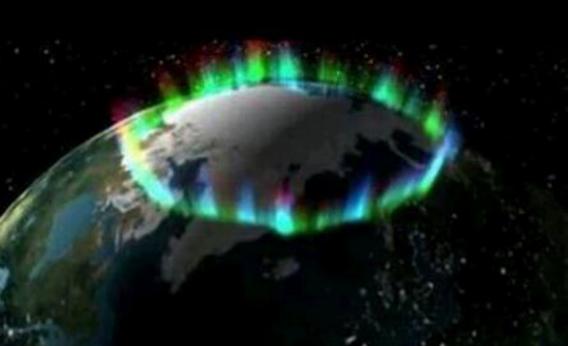Create a free profile to get unlimited access to exclusive videos, sweepstakes, and more!
No, That’s Not a Real Photo of an Aurora From Space

Facebook is to misinformation what a high school is to mono. Basically, it gets in there, and boom! Everyone shares it.
The culprit this time is a picture claiming to be an aurora taken from space. Here’s the photo:
I saw this linked from a Facebook page called ScienceDump, one of those accounts that posts pictures that are vaguely sciencey, and only sometimes gives links to further info or attribution for the images.
In this case, the only caption given was, “Ring of Fire. A picture taken by NASA of the Northern Lights from space.”
I knew right away that caption was completely wrong. For one thing, the Earth, stars, and aurorae simply don’t look real. Note the complete lack of clouds, for example. Second, the aurora aren’t that tall; those streamers are hundreds of miles in height, but in reality aurorae sheets are only a few miles in height.
I did a reverse image search using Google, and at first just found the usual reshares of this photo. I did find a few sites debunking the picture, but none knew where it was from. My biggest clue came from the sattrackcam blog, which dissects the image pretty well, but also mentions the shot was used in a video.
That gave me an idea. NASA’s Goddard Space Flight Center has an excellent video team, and I know a lot of their animations are online. I started poking around on their site, and it took a little while, but I finally found the exact original video this image is from!
The image comes in at the one-minute mark. The whole video is clearly computer generated. In fact, there’s a credit at the bottom of the GSFC page: “Visualizer/Animator: Walt Feimer (HTSI) (Lead)”; HTSI is for Honeywell Technology Solutions Inc. The video was created under contract to depict how the Earth’s magnetic field channels subatomic particles from the solar wind down into the atmosphere, where they make the air glow.
It only took me a few minutes to figure this all out. I did have the advantage of knowing about GSFC’s video page, but this ScienceDump page didn’t bother with fact checking or credit at all. Whoever runs it just made up a caption and ran with it. I’m no fan of these kinds of accounts; I see a lot of them on Facebook and Twitter, posting blatant garbage and claiming it’s real. ScienceDump appears to be marginally better than most, linking offsite to other sources. But this aurora photo shows it’s not 100 percent.
A good antidote for all this is to follow @FakeAstroPix and @PicPedant on Twitter (want a chuckle? Check out PicPedant’s background picture on their Twitter page; I could’ve saved myself some effort). @HoaxOfFame looks good, too. And, of course, there are hundreds of science communicators out there you can follow on social media to get the real scoop on real science.
I know that urge to retweet and share these kinds of photos can be strong, but I urge you not to subscribe to those kinds of accounts. Don’t get me wrong: It’s nice to get people excited with cool pictures and factoids, but from what I can see a lot (many? most?) of these sorts of accounts just post pictures while rarely giving credit or explaining them. And worse, a lot of them post total nonsense and even faked pictures, passing them off as real.
I’ve said this before, but it’s probably worth saying again, many times: The Universe is cool enough without making up crap about it.














